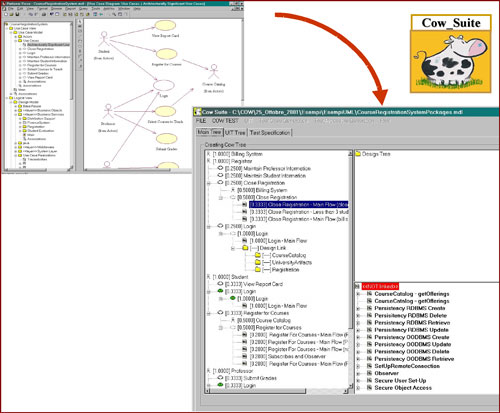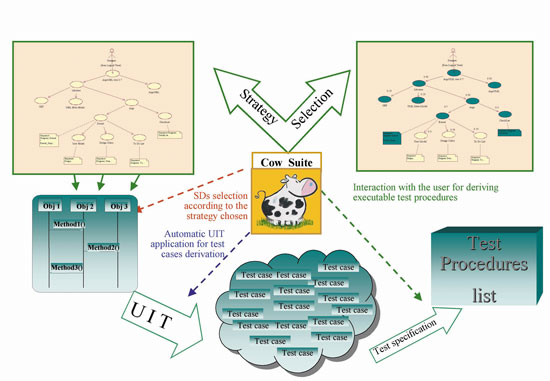|
|||||
Cow_Suite: A UML-Based Tool for Test-Suite Planning and Derivationby Francesca Basanieri, Antonia Bertolino, Gaetano Lombardi, Giovanni Nucera, Eda Marchetti and Alberto Ribolini The Cow_Suite tool provides an integrated, practical and tool-supported approach to the strategic generation and planning of Unified Modeling Language (UML)-based test suites for large industrial software systems. The tool can be adopted from the early stages of system analysis and modelling, and uses the UML diagrams developed for analysis and design without requiring any additional formalism or specific ad-hoc effort for testing purposes. The Cow_Suite (COWtest pluS UIT Environment) approach supports the early generation of high-level strategic test plans, which can be outlined during the early phases of software life cycles and continuously refined and updated throughout development as the design evolves. Cow_Suite combines two original components: a method to derive test cases, called UIT (Use Interaction Test), and a strategy for test prioritization and selection, called Cowtest (Cost-Weighted Test Strategy). These two components work in conjunction as Cowtest helps decide which and how many test cases should be planned within the universe of test cases that UIT could derive for the entire system under consideration. The tool was developed at ISTI-CNR in collaboration with Ericsson Lab Italy (ERI, Rome), within the framework of the PISATEL inititative. Cow_Suite Features
Cow_Suite Usage The tool execution starts by importing information on the UML design elements and organising it in a sort of hierarchy, whose root is represented by an Actor and leaves by Sequence or Communication Diagrams (see Figure 1). This hierarchy provides the user with a complete view of the status of the functionality specification and up-to-date documentation on Use Cases and their Realisation, Sequence and Communication Diagrams associated with each specification level, the reused nodes and those elements not linked with the other parts of the design.
At this point, users can annotate each node with a specific weight, representing the relative 'importance' of this node with respect to the other nodes at the same level, and choose between two supported test strategies: a fixed number of test cases, or fixed functional coverage. Users can then decide the integration level at which the test suite should be derived (or which of the elements of the UML model should be tested), by simply highlighting a portion of the hierarchy.
The UIT component will then automatically derive a list of test cases on the basis of the UML diagrams corresponding to the chosen integration level. These will be specified with a granularity corresponding to the degree of detail at which the considered diagrams are modelled. In Figure 2 we show a schema of the process adopted by the tool. Case Study
On the negative side we observed that the automatic derivation of test cases failed to include exceptional test cases, that is, test cases to handle abnormal system behaviour. This is reasonable and suggests that as good practice an expert should check the automated test plan before deployment to cover special situations. Further experimentation is of course desirable, and Cow_Suite is freely available in a prototype version for public usage. Link: Please contact: |
|||||




